 Pokotia Inscriptions
Pokotia Inscriptions Pokotia Inscriptions
Pokotia Inscriptions
Some time ago Bernardo Biados sent me photos of a monument he found at Pokotia.
The site of Pokotia is around 10 km south of Tiahuanaco (Tiwanaku). These insrcriptions are very interesting because they support the Fuente Magna evidence that the Sumerians formerly lived in South America.
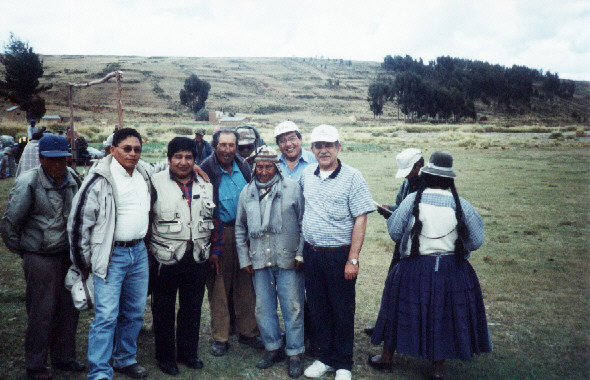
The inscriptions at Pokotia were discovered by Bernardo Biados, Freddy Arce, Javier Escalante, Cesar Calisaya, Leocadio Ticlla, Alberto Vasquez, Alvaro Fernholz, Omar Sadud, Rodrigo Velasco and Paulo Batuani. This monolith proves that the ancient South Americans had syllabic writing. Zecharia Sitchin, in The Lost Realms ( N.Y.: Avon Books, 1990) provides a great discussion of the evidence of writing in ancient Peru and Bolivia (pp. 148-152). He observed that Alexander von Humboldt, in Vues des cordillieres et monuments des peuples indigenes de Amerique (1824) wrote that "It has been recently out in doubt that the Peruvians had besides Quippus , knowledge of a sign script".
It is interesting to note that Sitchin published a picture of skin parchment he claims was formerly in the Peruvian museum at La Paz Bolivia, that have many of the signs found on the Fuente Magna bowl and the Proto-Sumerian script (p.150). According to Sitchin , it was published by Ribero and von Tschudi, in Reisen durch Sudamerika. If this parchment still exist in the museum it will provide even further support for the presence of Sumerian writing in South America.
The area where the Pokotia monument was found is a center of archaeological activity. In this area archaeologist have found numerous sites where pyramidial figures resembling ziggurats. These figures are expertly discussed by M. E. Moseley, The Incas and their ancestors (N.Y.: Thames and Hudson,2000). These ancient sites include Pukara at the northern end of Lake Titicaca, and Chiripa and Wankarani in Bolivia.
The ancient centers of this area are usually made in a u-shape. This style of archetecture was popular in the Huaura and Lurin Valleys. This u-shape tradition at Paraiso date back to 1900 BC (Moseley, p.138). Between 1200-800 BC, copper smelting existed at Wankarani and Chiripa. The Pukara site dates back to 400 BC
The Pokotia inscriptions show affinity to the inscriptions found on the Fuente Magna bowl. Below we list the signs found on the statue from Pokotia.
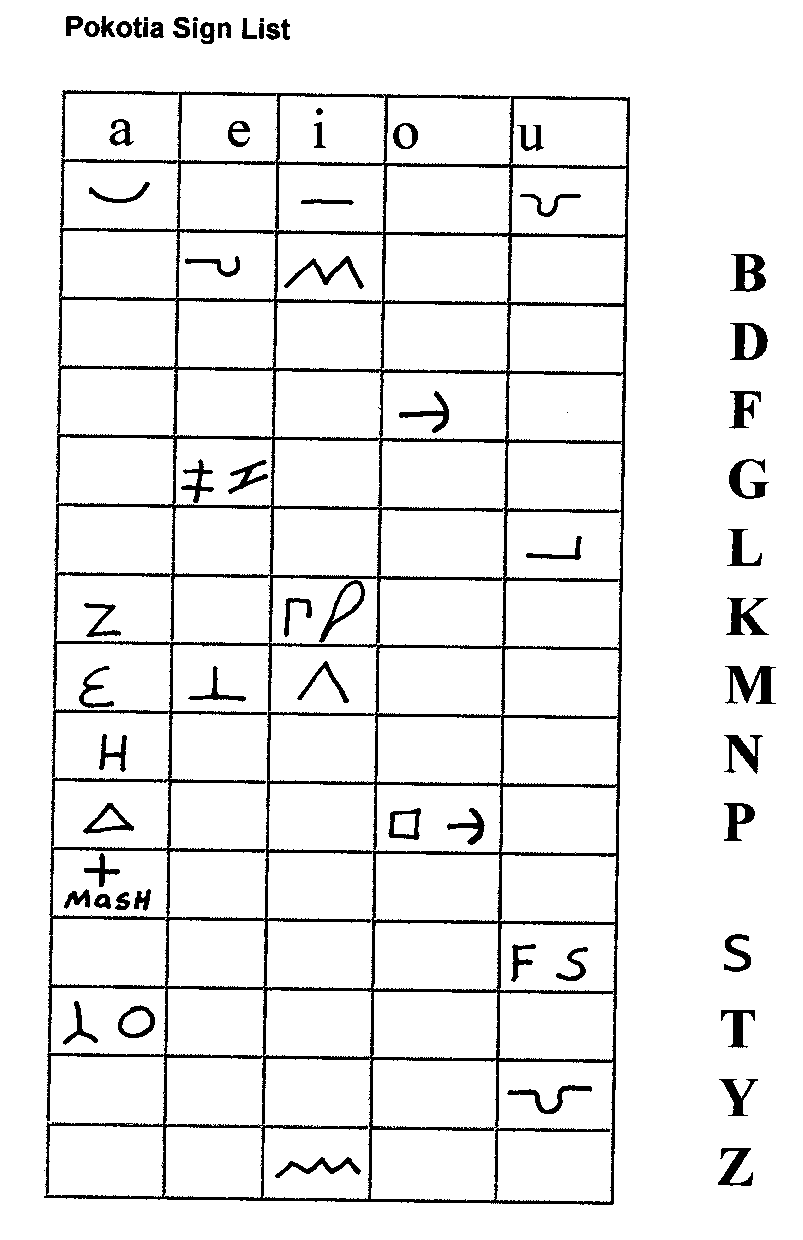
The Pokotia inscriptions are written in the Sumerian language. The signs are related to the Proto-Sumerian writing. The phonetic values for the signs are the phonetic values of similar signs found in the Vai writing. The sounds for the Vai writing were also used to interpret the Olmec writing and Indus Valley writing.
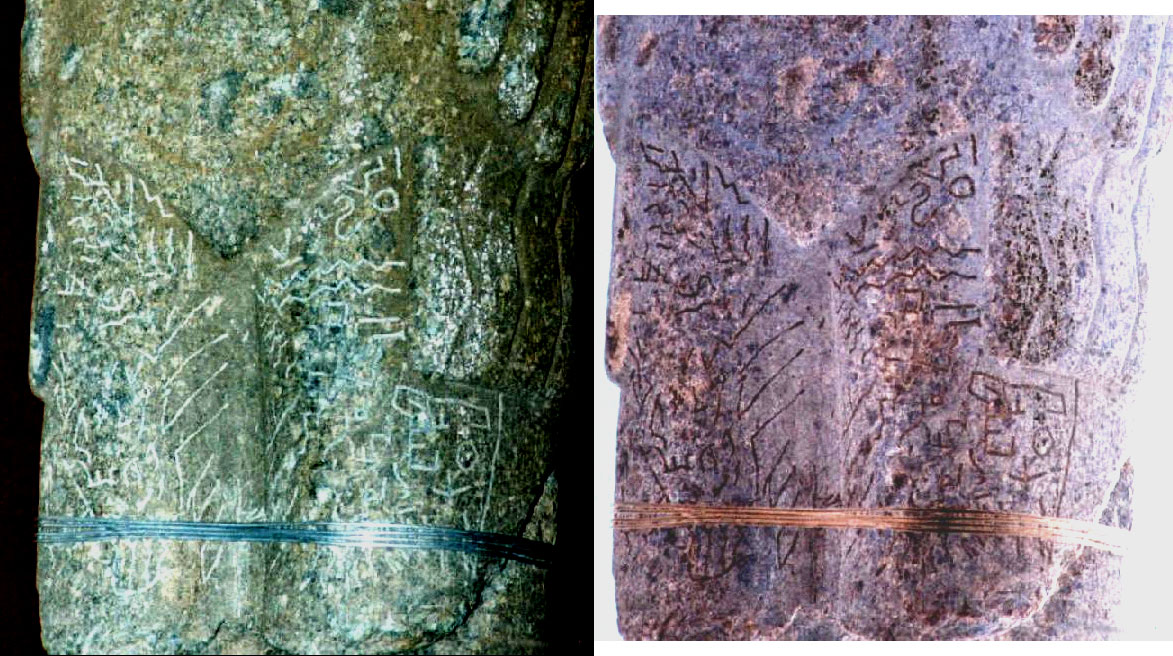
Pokotia Writing
The Pokotia signs are found on the front of the statue below the hands. The Pokotia signs are found on the right and left thighs of the figure.
The symbols on the Pokotia statue are read from top to bottom, right to left. The signs have syllabic values.
Below are the inscriptions from the left side of the Pokotia stela. These inscriptions are read from top to bottom, and right to left.
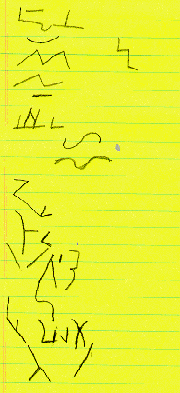
Transcription
Bi
Me be lu
A
Bi
Ka
I
Lu ge me I
Su
U(yu)
Ka mi
Mi I
Me I
Bi I
Mi ka
A I lu ki su
I ta
Translation:
" Distribute/ the opening of the Oracle to mankind./ Proclaim [that Putaki's] offspring (are to) witness esteem./Act justly (now), to send forth the oracle to nourish knowledge./ Appreciate the cult. [All to} witness the divine decree./ Send forth the soothsayer to capture the speech [from the oracle] to make clear the ideal norm [ for living, as a guide for mankind]. [Citizens] witness in favor of this human being to create wisdom (for all mankind), and send forth [an example of good] character [Indeed]!"
There is an additional inscription on the left side of the statue. This inscription is listed below:
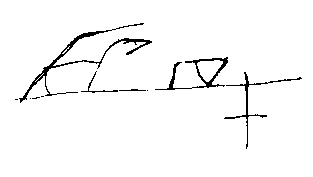
Transliteration:
Mash ge pa po mi lu su ta
Translation
"The Diviner proclaims the phenomenal depth of this area , of the deity's power, to entrust man with wisdom".
On the far right side of the Pokotia statue there are inscriptions which appear to be engraved in a box that provide the name of the oracle. Below is the inscription.

Transliteration
Fo/Pu ta ki
Na
Lu su Lu ki
Translation:
"Good Putaki, a wise man and progenator of (many) people."
There is an additional inscription on the right side of the statue.
This inscription is presented below:
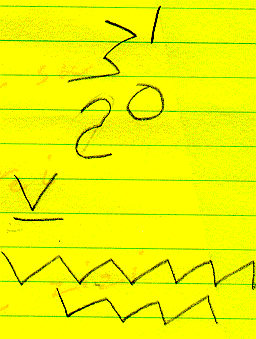
Transliteration
I bi
Ta gu
Mi I
Zi zi
Translation:
" Take an oath to witness character and wisdom. Witness the deity's power [ to make for you] a righteous soul".

Discussion
Bernardo's discovery of the Pokotia monument supports the research of the Verrills that the Sumerians came to South America in search of metals. A.H Verrill and R. Verrill, Americas ancient civilizations (New York: Putnam, 1953), and J. Bailey Sailing to Paradise, (New York: Simon & Schuster, 1994) maintain that the area around Lake Titicaca may have been called Lake Manu, by the Sumerians. According to the Verrills and Bailey the Sumerians came to this area in search of tin. They support this view by a discussion of the Sumerian traditions, that Sumerians set sail to the land west of the Mediterranean that they called the "Tin land of the West" or "Sunset Land". It is interesting to note that a major center in this area is Potosi. Bailey suggest that Potosi may relate to the Sumerian term Patesi the Sumerian term for 'priest king'.
The writing on the Pokotia monument makes it clear that the Pokotia oracle was a heard by many people in ancient Bolivia. This is interesting because the Pachacamac oracle was very popular in this area in historic times. According to Moseley , satellite shrines of one or another of his offspring were worshipped by South Americans (p.68).
During Inca (Sumerian: En-ka "Great Lord") times, the temple city of Pachacamac , contained the idol of Pachacamac which was a commanding oracle drawing devotees from Ecuador in the North through Bolivia in the South. People came from far and wide for a Pachacamac prophesy (Moseley, p.68). The Pokotia statue makes it clear that the popularity of oracles in this part of South America existed all the way back in time to the creation of the Putaki oracle.
There is other support of the early presence of writing in South America dating back to ancient times. Moseley published a number of inscribed Moche bricks and a Tiwanaku portrait head. The characters on the bricks and statue are identical to the Pokotia writing. The symbols on the inscribed Moche bricks are identical to the na, I, a, mash/bi, mi, ma, po, ki, ta and su signs listed on the Pokotia sign list above. The symbols on the Tiwanaku head are identical to the me and mash/bi signs found on the Pokotia statue.
In addition to evidence from South American popular culture (oracle worship) and archaeology there is linguistic evidence that support the Sumerian presence in Bolivia. Mario Montano has found startling linguistic evidence that indicates a Sumerian substratum in the Aymara and Quechua languages. These languages are spoken in Peru-Bolivia.
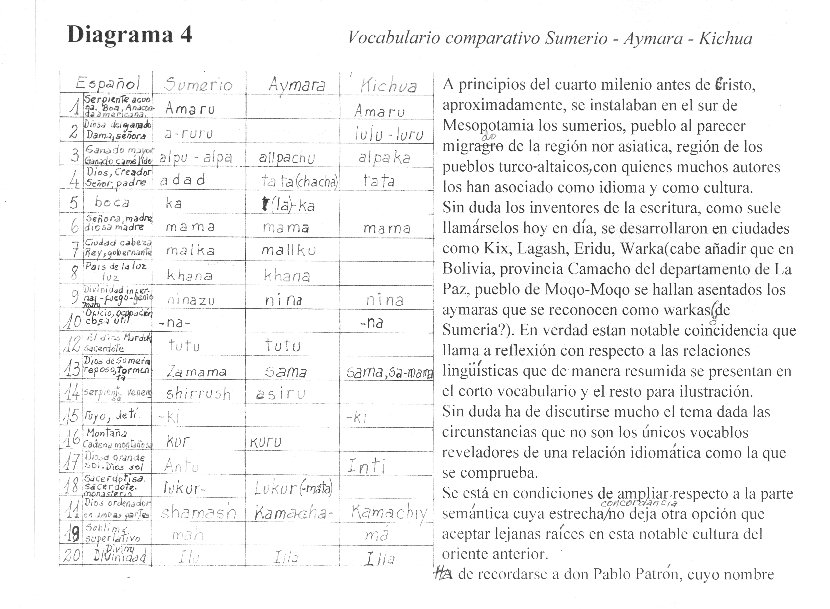
As you can see from the above table many Aymara terms relate to the metaphysical world. This is not surprising given this decipherment of the Pokotia statue and the Magna Fuente bowl which indicated that the Sumerians had established many aspects of their religion in Bolivia.
There are other Sumerian terms which relate to Aymara. These signs are listed below:
|
Aymara Sumerian (Word List) |
||
|
Aymara |
English Meaning |
Sumerian Etymology |
|
oinaya |
cloud |
murug |
|
kayu |
foot |
Giri |
|
Urta (full moon) |
moon |
Ud-sakar |
|
aycha |
flesh |
uzu |
|
Ch'uxna |
green |
Sig |
|
P'iqi |
head |
Sig |
|
Uma |
water |
Aa |
|
Inti |
sun |
Utu, du |
|
Urqu |
Man,male |
Ur |
|
Kunka Jaqi Apacita Qullu Uti Awki Chira Ch'iyara Waka |
Neck People Sacre mountain Hill House Father Seed Black Cow
|
Gun Uku, ulaku Duku Kur U, mu, bar Abba Gen Gig Ab |
It is clear from the above there is regular phonemic correspondence between many of the the Sumerian and Aymara terms for example: t
The linguistic evidence supports the view that many of these Sumerians were miners. The Sumerian term for copper was urudu, this term agrees with the Aymara terms for gold 'ouri' and copper 'anta, yawri'. The similarity between urudu and, yawri and ouri suggest that the Sumerians may have been the first people in the area to exploit the metals found throughout the Titicaca area and Bolivia.
The presence of Sumerian terms in the Aymara language, and Sumerian writing on the Fuente Magna bowl and Pokotia statue make it obvious that Sumerian civilization was formerly widespread in South America.
This leads me to believe that Bolivia and Peru, may represent the "Tin Land of the West" mentioned in the Sumerian inscriptions. If this is ture ancient Bolivia-Peru may have been called the mountains of Sunset or the "Sunset Land", by the ancient Sumerians.
Conclusion
In summary , the Pokotia statue is an oracle. The name of this oracle was Putaki. It would appear that formerly the area where the Pokotia monolithic was found was recognized as a major religious center where citizens came to hear the oracle recited by soothsayers or shamen. The Pokotia area along with other areas further north was probably the Sunset Land.
It is interesting to note that the name for the oracle Putaki is very close to the name of the site (Pokotia) where the artifact was found. This suggest continuity between the name of the oracle and the contemporary place name.
It is interesting to note that the Pokotia statue and Tiahuanaco monuments share similar headdresses and rib impressions along the chest area of several monuments.
I can not provide a date to the figure. But the fact that it was written in Sumerian, like the Fuente Magna bowl suggest that the Sumerian language continued to be spoken in this area for an extended period of time ( ). This suggest that we may find some Sumerian linguistic relations with the languages presently spoken in the area.


Pokotia Tiahuanaco
Here we see a comparison of the Pokotia and Tiahuanaco monolithic figures. The figures appear to be either in a setting pose or standing. In both cases the hands are placed on the side of the figures. The hands on the seated figure are placed on the knees.
These statues appear to have the same headdress and similar scarification across the chest or rib cage area. The general situation of similar "scarification" across the chest and headdress suggest that these artifacts may date back to the same period.

Statue from Tiahuanaco